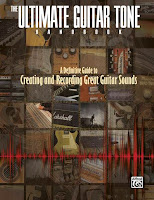But there's a real reason why tone controls are included on amps, and if used intelligently, they can really make a difference in how a guitar fits into the sound of a band or in a mix. Here's an excerpt from the Ultimate Guitar Tone Handbook
----------------------
So often players are confused by the tone controls on their amps (see Figure 7.1). What’s the best way to set them? Is there a method for doing so? In order to get the most out of them, it’s best to understand the reasons why they’re there in the first place.
The biggest reason for having tone controls is so that all the frequencies of your instrument speak evenly so no particular range is louder or softer than any other. Shortly after the first amps were developed with only a single “Tone” control, manufacturer’s noticed that players might be using guitars with different types of pickups with their amps, so more sophisticated tonal adjustments were really necessary. A guitar with a humbucking pickup might sound too boomy through an amp, but if you roll off the low-end with the bass control, the frequencies even out. Likewise, a Strat might be too light on the low-end or have too much top-end, but a simple adjustment would make all frequencies come out at roughly the same level.
Another place where tone controls come in handy is if you have a frequency that really jumps out, as compared to all the rest, either because of the way the amp is overdriven or because of a pedal. Often a slight adjustment of the Treble, Middle or Presence control can alleviate the problem, although these controls will also adjust all the frequencies around the offending one as well.
Where tone controls are especially effective is how the guitar fits within the context of the mix of the song. You want to be sure that every instrument is distinctly heard and the only way to do that is to be sure that each one sits in it's own particular frequency range, and the tone controls will help shape this. It's especially important with two guitar parts that use similar instruments and amps (like two Strats through two Fender Super Reverbs). If this occurs, it’s important to be able to shape your sound so that each guitar occupies a different part of the frequency spectrum. To make our example work in the mix, one guitar would occupy more of a higher frequency register while the other would be in a lower register, which would mean that one guitar has more high end while the second guitar is fatter sounding, or both guitars might have different mid-range peaks.
Not only do guitars have to sonically stay out of the way of each other, but they have to sit in a different frequency space than the bass and drums (and vocals, keys, percussion, and horns if you have them) too. As a result, you either adjust the tone controls on your amp or try another guitar so it fits better in the sonic space with everything else. While the engineer can do this with equalization either during recording or mixing, it’s always better if you get as close to the sound as possible out in the studio first because it will save time and sound better too.
The best way to get an ear for how guitars are sonically layered is to listen carefully to a number of hit songs in almost any genre and really dissect how everything fits together. Of course, the producer, engineer or artist (if you’re playing on someone else’s recording) will also have specific ideas as to the sound they’re looking for in the track, and will guide you in that direction.
To read more excerpts from the book, go to the excerpt section of the bobbyowsinski.com website.
----------------------------------
Help support this blog. Any purchases made through our Amazon links help support this website with no cost to you.
You should follow me on Twitter for daily news and updates on production and the music business.
Don't forget to check out my Music 3.0 blog for tips and tricks on navigating social media and the new music business.



2 comments:
Dear Bobby,
Thanks for the post and for the blog generally.
Some of the blues guys around Milwaukee told me to set the tone controls of my amp with the treble around 7 and the bass and mids at 0.
The sound had bite to cut through the band and be heard, but it didn't take up alot of room in the overall spectrum.
That's the only other theory of tone I am aware of.
Any thoughts?
Thanks again,
Fred Decker
Sure, that can work, Fred. I wouldn't use that on everything though. With a power trio there's more space to fill so the guitar would need more bottom, for instance.
Post a Comment